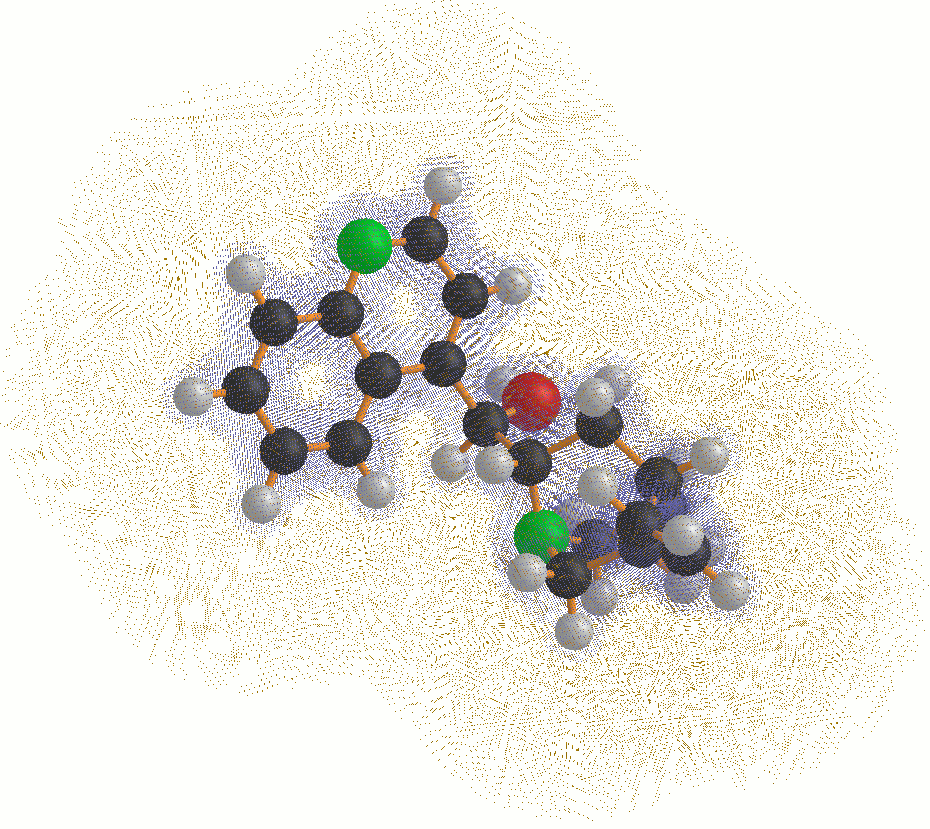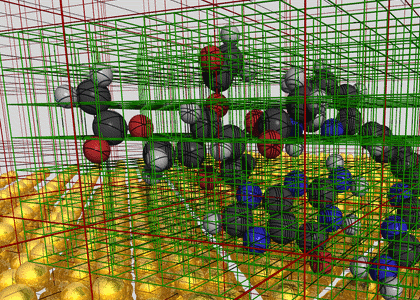In der Vergangheit haben wir diese Ansätze zumeist im Rahmen von Randintegralgleichungsme- thoden eingesetzt. Momentan konzentrieren wir uns auf die numerische Behandlung von ab initio

Zu Lösung müssen neben einer effizienten Diskretisierung großskaligen nichtlineare Eigenwertaufgaben und Optimierungsprobleme behandelt werden.
- DFG-Schwerpunktprogramms SPP1145
"Adaptives Lösungsverfahren für die Coupled-Cluster-Gleichung und Tensorprodukt-Approximation von Zweielektronenintegralen."
Homepage - DFG-Schwerpunktprogramms 1324
"Mathematische Methoden zur Extraktion quantifizierbarer Information aus komplexen Systemen"
Homepage - Projekt A7 im DFG Forschungscentrum Matheon
"Numerical Discretization Methods in Quantum Chemistry"
Homepage
Abstrakt:
Um bei der Berechnung der Elektronenstruktur eine bezüglich des Rechenaufwands optimale Komplexität
zu erzielen, d.h.~lineare Abhängigkeit von der Systemgröße bzw. der Anzahl an Freiheitsgraden,
ist der Einsatz adaptiver Methoden unerläßlich. Im ersten Teil unseres Projekts möchten wir
neuere Konzepte aus der Mehrskalenanalysis zur Entwicklung adaptiver Algorithmen für Coupled-Cluster
und Configuration-Interaction-Methoden heranziehen. Hierbei bezieht sich Adaptivität
auf die Auswahl derjenigen Anregungsamplituden welche den größten Einfluß auf die Energie ausüben.
Verschiedene derartige Ansätze sind aus der Literatur bekannt, wobei es unsere Absicht ist
einige neue mathematisch motivierte Ideen einzubringen, wie die Wahl einer geeigneten Norm für
die Auswahl der Amplituden sowie die Anwendung von a posteriori Fehlerschätzern.
Der zweite Teil unseres Projekts beschäftigt sich mit
der effizienten Berechnung von Zweielektronenintegralen, einem typischen Engpaß bei
quantenchemischen Rechnungen. Wir möchten adaptive Konzepte in unser kürzlich
entwickeltes, auf optimalen Tensorprodukt-Approximationen basierendes Verfahren
einbinden. Dies läßt sich dadurch bewerkstelligen, daß man hierarchische Tensorprodukt-Zerlegungen
konstruiert sowie adaptive Algorithmen für die Faltung mit dem Coulombpotential verwendet.
Abstrakt:
| Many challenging problems of numerical computations arise from problems involving a high spatial dimension. For a fine grid resolution even 3 dimensions cause a problem, but 6 or even much higher dimensions require quite new methods, since the standard approaches have a computational complexity growing exponentially in the dimension ( curse of dimensionality). A remedy is the use of data-sparse matrices or corresponding constructions exploiting tensor product representations. Here, we focus on eigenvalue problems in this field. While the design of the algorithms is rather general, the main application are problems from electronic structure |  |
| calculations. Many of the developed methods may be applied to general problems stemming from elliptic differential or integral operators. In particular, the basic electronic Schrödinger equation is an eigenvalue problem for an elliptic 2nd order partial differential equation in high dimensions. Alternative to a direct treatment of this original problem we would like to exploit successful developments in quantum chemistry, mainly putting newly developed methods on top of well established electronic structure programs. A major focus will be on eigenvalue problems in Density Functional Methods. Perhaps there are further instances where the development of the project would contribute to numerical methods in electronic structure calculation, e.g. adaptive configuration interaction (CI) and coupled cluster (CC) methods and Jastrow factor calculation. | |
Abstrakt:
| Computer simulation plays an ever expanding role in modern scientific research, and the fields of chemistry, biochemistry, and pharmaceutical research are no exceptions. The model on which our physical understanding of chemistry rests is the Schrödinger equation, the basic equation of quantum mechanics. Approximation techniques for its solutions is an active area of research spanning the fields of chemistry, physics, and applied mathematics. The main problem is that this equation is an equation in 3N space dimensions for a system consisting of N electrons and nuclei. The so-called "curse of dimensionality" prohibits direct approximation techniques for even reasonably |  |
| small systems, and a host of methods have been discovered over the past decades which attack the problem from other approaches. However recent developments indicate that the curse of dimensionality might be broken---or at least brought into the realm of numerical tractability. Among these developments is an improved understanding of the "regularity" of the solutions, together with advances in sparse grid techniques from numerical analysis. The goal of this project is to further refine these ideas and to implement them in efficient numerical algorithms. | |